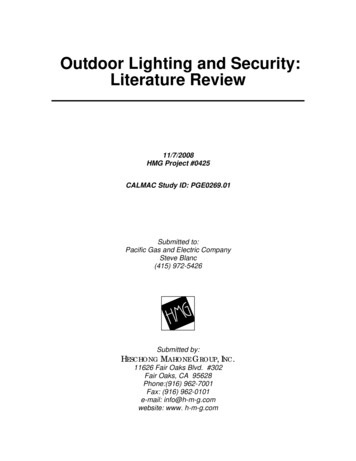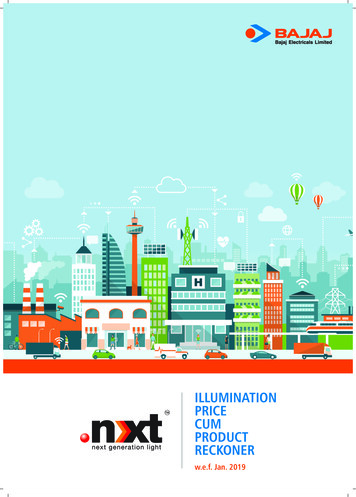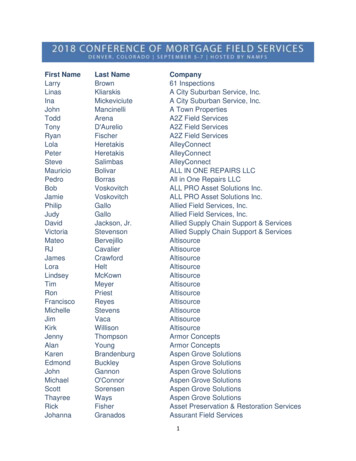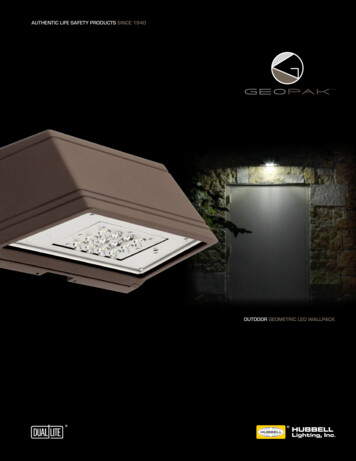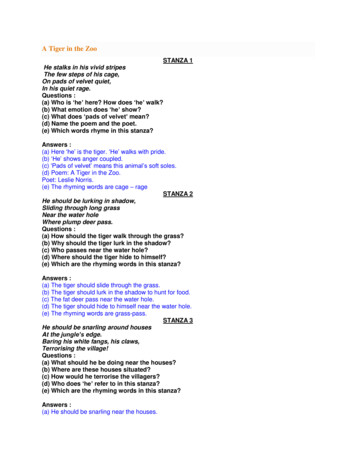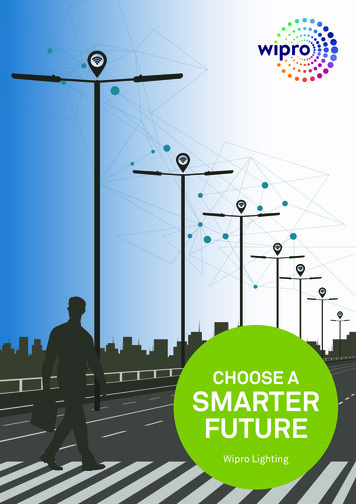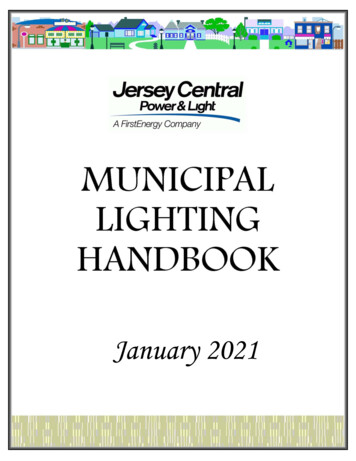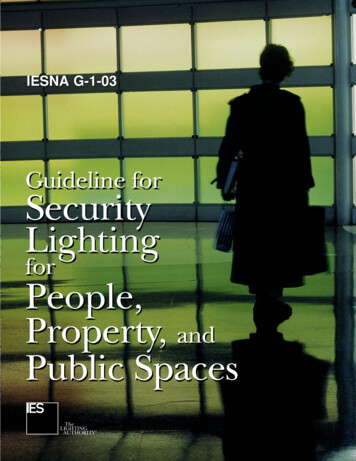
Transcription
IESNA G-1-03Guideline forSecurityLightingforPeople,Property, andPublic SpacesTheLIGHTING AUTHORITY
IESNA G-1-03GuidelineforSecurity LightingforPeople, Property, and Public SpacesPublication of this CommitteeReport has been approvedby the IESNA. Suggestions forrevisions should be directedto the IESNA.Prepared by:IESNA Security Lighting Committee
Copyright 2003 by the Illuminating Engineering Society of North AmericaApproved by the IESNA Board of Directors, March 1 , 2003 as a Transaction of the Illuminating EngineeringSociety of North America.All rights reserved. No part of this publication may be reproduced in any form, in any electronic retrieval systemor otherwise, without prior written permission of the IESNA.Published by the Illuminating Engineering Society of North America, 120 Wall Street, New York, New York 10005.IESNA Standards and Guidelines are developed through committee consensus and produced by the IESNAOffice in New York. Careful attention is given to style and accuracy. If any errors are noted in this document, pleaseforward them to Rita Harrold, Director Educational and Technical Development, at the above address for verification and correction. The IESNA welcomes and urges feedback and comments.ISBN # 0-87995-190-7Printed in the United States of America.DISCLAIMERIESNA publications are developed through the consensus standards development process approved by theAmerican National Standards Institute. This process brings together volunteers representing varied viewpoints and interests to achieve consensus on lighting recommendations. While the IESNA administers theprocess and establishes policies and procedures to promote fairness in the development of consensus, itmakes no guaranty or warranty as to the accuracy or completeness of any information published herein.The IESNA disclaims liability for any injury to persons or property or other damages of any nature whatsoever, whether special, indirect, consequential or compensatory, directly or indirectly resulting from the publication, use of, or reliance on this documentIn issuing and making this document available, the IESNA is not undertaking to render professional or otherservices for or on behalf of any person or entity. Nor is the IESNA undertaking to perform any duty owed byany person or entity to someone else. Anyone using this document should rely on his or her own independent judgment or, as appropriate, seek the advice of a competent professional in determining the exerciseof reasonable care in any given circumstances.The IESNA has no power, nor does it undertake, to police or enforce compliance with the contents of thisdocument. Nor does the IESNA list, certify, test or inspect products, designs, or installations for compliancewith this document. Any certification or statement of compliance with the requirements of this document shallnot be attributable to the IESNA and is solely the responsibility of the certifier or maker of the statement.
IESNA G-1-03Prepared by the Security Lighting Committee, and Sub-Committee on RelationshipBetween Lighting and Crime, Illuminating Engineering Society of North America.Committee Members:David L. Salmon, Ph.D., CPO, Chair 1998 – 2002Brian J. Scanlon, Chair 2002 –Theodore Ake, LCCraig R. Bertolett, Sr.**Norman R Bottom, Ph.D., CPP, CPODavid Crawford, Ph.D., FIESRobert DanielsDavid DeanL. Vern ForemanJohn G. Hayes, Ph.D., CPPJames HominsGary HovaterFred D. JusticeRobert E. KaeserHyman Kaplan, L.C., P.E.Lorence E. Leetzow*Robert LovelaceDouglas W. PaulinJeffrey RocheMike RossDavid L. Salmon, IIC. Stanley Stubbe*David Stymiest P.E., SASHE, CEM *C. S. ThomasTimothy J. Walsh, CPP* Advisory** HonorarySub-Committee – Relationship Between Lighting and CrimeDavid L. Salmon, II, ChairNorman Bottom, Ph.D., CPP, CPORobert E. KaeserDavid L. Salmon, Ph.D., CPOBrian J. ScanlonEditing Task GroupTheodore Ake, LC, ChairPeter BoyceDouglas W. PaulinBrian J. Scanlon
IESNA G-1-03Table of ContentsForeword and History . . . . . . . . . . . . . . . . . . . . . . . . . . . . . . . . . . . . . . . . . . . . . . . . . . . . . . . . . . . . . . . 11.0Introduction . . . . . . . . . . . . . . . . . . . . . . . . . . . . . . . . . . . . . . . . . . . . . . . . . . . . . . . . . . . . . . . . . . . . . . . 11.1 Lighting and its Relationship to Crime. . . . . . . . . . . . . . . . . . . . . . . . . . . . . . . . . . . . . . . . . . . . . . 12.0Scope and Purpose . . . . . . . . . . . . . . . . . . . . . . . . . . . . . . . . . . . . . . . . . . . . . . . . . . . . . . . . . . . . . . . . . 23.0Basic Principles of Security and Security Lighting. . . . . . . . . . . . . . . . . . . . . . . . . . . . . . . . . . . . . . . . 33.1 Principles . . . . . . . . . . . . . . . . . . . . . . . . . . . . . . . . . . . . . . . . . . . . . . . . . . . . . . . . . . . . . . . . . . . 33.2 Community Responsive Design . . . . . . . . . . . . . . . . . . . . . . . . . . . . . . . . . . . . . . . . . . . . . . . . . . 43.3 Security Lighting Planning . . . . . . . . . . . . . . . . . . . . . . . . . . . . . . . . . . . . . . . . . . . . . . . . . . . . . . 54.0Understanding “When Security is an Issue” . . . . . . . . . . . . . . . . . . . . . . . . . . . . . . . . . . . . . . . . . . . . . 55.0Visibility Concerns in Security Applications . . . . . . . . . . . . . . . . . . . . . . . . . . . . . . . . . . . . . . . . . . . . . 65.1 Illuminance . . . . . . . . . . . . . . . . . . . . . . . . . . . . . . . . . . . . . . . . . . . . . . . . . . . . . . . . . . . . . . . . . . 65.2 Horizontal Illuminance. . . . . . . . . . . . . . . . . . . . . . . . . . . . . . . . . . . . . . . . . . . . . . . . . . . . . . . . . 135.3 Vertical Illuminance . . . . . . . . . . . . . . . . . . . . . . . . . . . . . . . . . . . . . . . . . . . . . . . . . . . . . . . . . . . 135.4 Uniformity . . . . . . . . . . . . . . . . . . . . . . . . . . . . . . . . . . . . . . . . . . . . . . . . . . . . . . . . . . . . . . . . . . 135.5 Glare. . . . . . . . . . . . . . . . . . . . . . . . . . . . . . . . . . . . . . . . . . . . . . . . . . . . . . . . . . . . . . . . . . . . . . 135.6 Shadows. . . . . . . . . . . . . . . . . . . . . . . . . . . . . . . . . . . . . . . . . . . . . . . . . . . . . . . . . . . . . . . . . . . 135.7 Establishing Site Divisions . . . . . . . . . . . . . . . . . . . . . . . . . . . . . . . . . . . . . . . . . . . . . . . . . . . . . 135.8 Total Site Zone . . . . . . . . . . . . . . . . . . . . . . . . . . . . . . . . . . . . . . . . . . . . . . . . . . . . . . . . . . . . . . 135.9 Pedestrian Zone . . . . . . . . . . . . . . . . . . . . . . . . . . . . . . . . . . . . . . . . . . . . . . . . . . . . . . . . . . . . . 145.10 Pedestrian Path Zone . . . . . . . . . . . . . . . . . . . . . . . . . . . . . . . . . . . . . . . . . . . . . . . . . . . . . . . . . 145.11 Building Zone . . . . . . . . . . . . . . . . . . . . . . . . . . . . . . . . . . . . . . . . . . . . . . . . . . . . . . . . . . . . . . . 145.12 Building Perimeter Zone . . . . . . . . . . . . . . . . . . . . . . . . . . . . . . . . . . . . . . . . . . . . . . . . . . . . . . . 156.0Lighting Equipment . . . . . . . . . . . . . . . . . . . . . . . . . . . . . . . . . . . . . . . . . . . . . . . . . . . . . . . . . . . . . . . . 167.0Security Lighting for Controlled Spaces . . . . . . . . . . . . . . . . . . . . . . . . . . . . . . . . . . . . . . . . . . . . . . . 207.1 General. . . . . . . . . . . . . . . . . . . . . . . . . . . . . . . . . . . . . . . . . . . . . . . . . . . . . . . . . . . . . . . . . . . . 207.2 Specific Applications . . . . . . . . . . . . . . . . . . . . . . . . . . . . . . . . . . . . . . . . . . . . . . . . . . . . . . . . . . 217.2.1 Unoccupied Spaces . . . . . . . . . . . . . . . . . . . . . . . . . . . . . . . . . . . . . . . . . . . . . . . . . . 227.2.2 Offices and Other Buildings. . . . . . . . . . . . . . . . . . . . . . . . . . . . . . . . . . . . . . . . . . . . . 237.2.3 Automated Teller Machines and Night Depositories . . . . . . . . . . . . . . . . . . . . . . . . . . 257.2.4 Parking Facilities (Lots and Garages) . . . . . . . . . . . . . . . . . . . . . . . . . . . . . . . . . . . . . 277.2.5 Residential Parking Areas . . . . . . . . . . . . . . . . . . . . . . . . . . . . . . . . . . . . . . . . . . . . . . 277.2.6 Parking Lots and Areas for Public Parks . . . . . . . . . . . . . . . . . . . . . . . . . . . . . . . . . . . 287.2.7 Supermarkets and Major Retail Outlets. . . . . . . . . . . . . . . . . . . . . . . . . . . . . . . . . . . . 287.2.8 Fast Food and Franchise Restaurants . . . . . . . . . . . . . . . . . . . . . . . . . . . . . . . . . . . . 297.2.9 Convenience Stores and Gas Stations . . . . . . . . . . . . . . . . . . . . . . . . . . . . . . . . . . . . 307.2.10 Single-Family Residences. . . . . . . . . . . . . . . . . . . . . . . . . . . . . . . . . . . . . . . . . . . . . . 317.2.11 Multi-Family Residences and Dormitories . . . . . . . . . . . . . . . . . . . . . . . . . . . . . . . . . . 327.2.12 Multi-Family Residences for the Elderly . . . . . . . . . . . . . . . . . . . . . . . . . . . . . . . . . . . 337.2.13 Schools & Institutions . . . . . . . . . . . . . . . . . . . . . . . . . . . . . . . . . . . . . . . . . . . . . . . . . 347.2.14 Law Enforcement, Fire, Ambulance, and Other Emergency Services . . . . . . . . . . . . . 347.2.15 Hotels and Motels . . . . . . . . . . . . . . . . . . . . . . . . . . . . . . . . . . . . . . . . . . . . . . . . . . . . 35
IESNA G-1-038.0Glossary of Terms . . . . . . . . . . . . . . . . . . . . . . . . . . . . . . . . . . . . . . . . . . . . . . . . . . . . . . . . . . . . . . . . . 36References . . . . . . . . . . . . . . . . . . . . . . . . . . . . . . . . . . . . . . . . . . . . . . . . . . . . . . . . . . . . . . . . . . . . . . . 38Annexes . . . . . . . . . . . . . . . . . . . . . . . . . . . . . . . . . . . . . . . . . . . . . . . . . . . . . . . . . . . . . . . . . . . . . . . . . 39Annex A-Studies on Lighting and its Relationship to Crime . . . . . . . . . . . . . . . . . . . . . . . . . . . . . . . . . 39Annex B-Physical Security Survey. . . . . . . . . . . . . . . . . . . . . . . . . . . . . . . . . . . . . . . . . . . . . . . . . . . . 40Annex C-Taking Security Illumination Measurements—A Practical Guide . . . . . . . . . . . . . . . . . . . . . . 44Annex D-Crime Analysis and Foreseeability of Crime . . . . . . . . . . . . . . . . . . . . . . . . . . . . . . . . . . . . . 47Annex E-Crime Prevention Through Environmental Design [CPTED] . . . . . . . . . . . . . . . . . . . . . . . . . 52Annex F-Lighting for Television and Photographic Surveillance . . . . . . . . . . . . . . . . . . . . . . . . . . . . . . 58Annex G-Municipal Approvals . . . . . . . . . . . . . . . . . . . . . . . . . . . . . . . . . . . . . . . . . . . . . . . . . . . . . . . 60Annex H-Additional Reading . . . . . . . . . . . . . . . . . . . . . . . . . . . . . . . . . . . . . . . . . . . . . . . . . . . . . . . . 61
IESNA G-1-03IESNA G-1 Security Lighting for People, Property,and Public SpacesForeword and HistoryDuring World War I, the U.S. Government recognizedthe need for industry to increase exterior lighting atkey production facilities, docks, assembly yards, highsecurity facilities, and railway yards. These improvements had two purposes, to aid in production, and todeter sabotage. Although exterior protective lightingwas widely increased, no standard was set. With the advent of World War II, at the request ofthe War Department, Military Intelligence, withassistance from the Insurance Committee for theProtection of American Industrial Plants, and theAmerican Standards Association (ASA), initiated aproject to develop a standard on outdoor protectivelighting for industrial properties. The primary purpose of these efforts was to prevent theft and sabotage. Additionally, it was soon realized that “lightdiscipline” was important to the war effort. Coastalfacilities were darkened, and stray light was strictlycontrolled. North America was learning the importance of good security lighting and lighting discipline.During 1942, the ASA War Standards Procedurewas applied, and a War Standards Committee prepared and published American Standard, A851942, Protective Lighting for Industrial Properties.This eventually became an ANSI Standard. In 1948, the ASA Safety Code CorrelatingCommittee terminated War Standards and instituted a revised standard for peacetime use. TheIlluminating Engineering Society was designatedAdministrative Sponsor for this effort. The IES Protective Lighting Committee developedthe first draft of this revision, which the SectionalCommittee used as a basis for an AmericanNational Standard Practice. In 1977, The Protective Lighting Committee, IES,sponsored, wrote, and published AmericanNational Standard Practice for Protective LightingRP-10. This standard was intended as a guide foroutdoor protective lighting to those responsible forplant protection.1 In 1994, a Security Lighting Committee was formedby the IESNA. Its first project was to write a modern guideline for security lighting for North America.During 1997-1998, the Security Lighting Committeedeveloped material that was the basis for Chapter29 of the IESNA Lighting Handbook, Ninth Edition.2 During 1999, members of the Security LightingCommittee outlined the contents and approach fora guideline for peer review and comment beforeseveral professional groups. These groups included the American Society of Safety Engineers, andthe American Society for Industrial Security. During 2000, additional presentations were madebefore professional security groups concerned withthe safety and security of the public, including theInternational Conference on Shopping Centers andthe American Society of Industrial Security.1.0 INTRODUCTIONThe Security Lighting Committee, previously knownas The Protective Lighting Committee of theIlluminating Engineering Society of North America(IESNA), was established to generate and developcriteria for lighting to enhance the security of peopleand property, to recommend the integration and interaction of lighting as part of a total security system, andto write a publication.1.1Lighting and its Relationship to CrimeThe possibility that lighting might have an impact onthe incidence of crime was a topic of interest in theUnited States in the sixties. Municipalities acrossAmerica improved their street lighting to combat crimeand some encouraging results were reported, but onreview there was no significant statistical evidence thatimproved street lighting influenced the level of streetcrime. There was, however, an indication that theimproved street lighting decreased the fear of crime.Twenty years later, in 1988, a before and after relighting study of a street in the outer city area of London,England, by K. Painter demonstrated a marked reduction in the incidence of crime and the fear of crime onthe relighted street. (See Annex A.)This lead to an outburst of similar studies in the UK byPainter (1989, 1991, 1994), Barr and Lawes (1991),Burden and Murphey (1991), Davidson and Goodey(1991), Herbert and More (1991), Glasgow CrimeTeam (1992, Nair (1993), Ditton and Nair (1994) andCridland (1995). The results were mixed.The most sophisticated study undertaken on the effectof lighting on the incidence of crime was in 1999 inStoke-on-Trent in England by Painter and Farrington.1
IESNA G-1-03Three areas of housing were selected; one was theexperimental area where the lighting was improved;one was designated the adjacent area; the third wasthe control area, which served as the baseline againstwhich any changes in crime could be monitored. Thelighting in the adjacent and control areas remainedunchanged. One aspect of the study was to see ifimproved lighting in one area might lead to similar benefits of crime reduction in the adjacent area. There wasa marked reduction in the prevalence of crimes suchas theft and vandalism, vehicle crime, and personalcrime in the experimental area after relighting. Therewas no significant change in the adjacent or controlareas. A similar study in the town of Dudley, England,showed that the level of delinquency decreased morein the relighted area than in the control area.The results of all these studies indicate that lighting hasa place to play in crime prevention. A list of sources forfurther reading may be found in Annex A. While thereare no guarantees that improved lighting will cause adecrease in crime, there are circumstances in whichlighting can be an effective crime countermeasure,either alone or in combination with other measures.Lighting can affect crime by two indirect mechanisms. The first is the obvious one of facilitatingsurveillance by the authorities and the communityafter dark. If such increased surveillance is perceived by criminals as increasing the effort andrisk and decreasing the reward for a criminal activity, then the level of crime is likely to be reduced.Where increased surveillance is perceived by thecriminally inclined not to matter, then better lighting will not be effective.The second mechanism bywhich an investment in better lighting might affectthe level of crime is by enhancing community confidence and hence increasing the degree of informal social control. This mechanism can be effective both day and night but is subject to manyinfluences other than lighting.2.0 SCOPE AND PURPOSEThe primary purpose of this publication is to establishguidelines for the design and implementation of security lighting.* It addresses security illumination but doesnot give advice on construction practices. The objectiveis to provide guidance for designing security lightingsystems for new facilities and for evaluating existingfacilities and systems. This publication is intended forNote the distinction made in this document between security lighting and lighting for*safety.Security lighting is intended to protect people and property from criminal activities.Lighting for safety is intended to provide safe working conditions, safe passage and identification of hazards or obstructions.2the use of property owners and managers, crime prevention specialists, law enforcement and security professionals, risk managers, lighting specifiers, contractors, the legal profession, and homeowners who areconcerned about security and the prevention of crime.Crime, its prevention, and the application of lighting tohelp minimize criminal activity, are considered in a lesstechnical and user-friendly manner for the benefit ofproperty owners, but illuminating engineers, architectsand other professionals should find the concepts usefulto review with their clients.The primary measurement references throughout thisdocument are metric, with the English equivalent inparenthesis. For example, 1.5 meters will be displayed as 1.5 m (5 ft), and 100 lux will be displayed as100 lux (10 fc). These conversions are approximate,but considered sufficiently accurate in this context.In this publication will be found a discussion of basicsecurity principles, illuminance requirements for various types of properties, a protocol for evaluating current lighting levels for different security applications,and security survey and crime search methodology.The guidelines are based on consensus among members of the IESNA Security Lighting committee andother security experts.Suggestions are given for exterior and interior security lighting practices for the reasonable protection ofpersons and property. This document also promotesa concept of best practice, which takes into accountthe following lighting design issues: Economics (including cost, maintenance and operational costs)Environmental issues (including light pollution, lighttrespass and the adverse effects of light on animalsand plants)Municipal lighting ordinances, by-laws or codesEnergy conservation, and maintenance requirementsMinimum guidelines for the safe movement of persons and equipment and for performing specific taskscan be found in other IESNA publications. This document is intended to provide specific guidelines whereit has been determined that security is an issue, andwhere security is an important determining factor inthe design or retrofit of a given property.Note that throughout this guideline the phrasewhen security is an issue is used to differentiatethe lighting design suggestions presented hereinfrom those contained in other IESNA publications.While these other publications may make reference to security, in G-1 it is the only issue. Note toothat when security is an issue, not only lighting,
IESNA G-1-03but all measures and system components areincreased and/or strengthened; for example, personnel, surveillance, gates, locks, and fences.Security lighting, as part of a well-balanced securityplan, should have the following objectives:1. Provide a clear view of an area from a distanceand enable anyone moving in or immediatelyaround it to be easily seen2. Deny potential hiding spaces adjacent to frequently traveled foot routes3. Permit facial identification at distance of at least9 m (30 ft), and create the perception of beingidentifiable4. Facilitate the proper use of other securitydevices available on the property5. Deter crime against persons or property6. Enhance the public’s feeling of comfort inaccessing spaces and increase night-timepedestrian traffic3.0 BASIC PRINCIPLES OF SECURITY ANDSECURITY LIGHTING3.1PrinciplesSecurity lighting is installed to help protect people andproperty from criminal activities, and to create a perception of security. To better understand the principlesof security lighting, it is first appropriate to look at several key security tenets.Responsibility - In North America, the burden of security and safety is generally placed on the individualswho have primary control over a given property. Withthe rights of control comes the responsibility of control. For example, a property owner can enforce rulesof trespass, install security systems, restrict access,and make other decisions that may have far reachingconsequences for those who access the property. Toa lesser degree, a tenant of the property may share inthis control and responsibility for the sublet space.Owners and operators have or should have, a superior knowledge of the site’s history, including crime.Casual visitors, invitees, or customers generally haveno responsibility for security at a given site since theyare not able to exercise reasonable control over theevents at the location, or influence the environment. Itis generally the responsibility of a resident, businessoperator, or property owner to provide for the safetyand protection of human life and the property.Anticipating the threat - A helpful approach in determining the security needs of a property or operation isto study the opportunity, means, and motivation ofpotential perpetrators. Security works to deny opportunity, and increase the level of means or resourcesnecessary for the criminal to successfully attack thetarget, and escape. When opportunity is limited, and alarge amount of time and resources are required tosuccessfully complete a criminal act and escape,criminal motivation declines.Time - Time is the criminal’s enemy. The longer acriminal act takes in planning, execution, and escape,the more likely the crime will be deterred. Most common criminals will choose a property that requires theleast amount of stealth, equipment, and planning.Target hardening - A target is harder to attack whencoordinated security elements are provided. In theprocess of target hardening, deterrent objectives areset, options reviewed, and steps taken to improvesecurity. The target is the people or property to be protected, and the various security features are the hardening elements. Each separate security element addsto the others, making the target harder to attack.Security elements available to the professional will varyby situation, but often include management controls,perimeter protection, a means of surveillance,response capabilities, and security lighting. A goodsecurity plan will contain layers of security features, andwill not rely on one single security feature for success.Fight or flight - The basic decision made by personswhen threatened is fight or flight. In other words isdefense or evasion the appropriate measure?Sometimes, the act of fleeing danger is simply not anoption due to circumstances. Fight may be the physical act of defense or a call for help. For police or security officers, it usually means some form of physicaldefense for serious threats. Flight, on the other hand,may mean moving to a safe place, or getting out of theway of a presumed threat. Lighting, if properlyinstalled and maintained, can play an important role inhelping people make this basic decision.Security elements - Security elements can be active orpassive deterrents. Active elements have the capacity tointeract with persons or generate a response to a criminal’s actions. Passive elements include those securityfeatures and applications that are static in nature and donot interact with a would-be intruder or criminal.Passive elements for a home or business may includedeterrent features such as perimeter fencing or walls,open or barrier landscaping, exterior and interior illumination systems, safes, open areas, and warning signs.The most active deterrent is a patrol officer. The effectiveness and response of uniformed individuals making patrol rounds is often hard to predict, causing a3
IESNA G-1-03would-be criminal to pause. Other active applications,in wide use, include: interactive alarm systems, cardor coded entry devices, metal detectors, security andpolice officers, and trained animals such as dogs andgeese. Some elements may be classified as bothactive and passive deterrents. For example, monitored closed-circuit television (CCTV), where there isa response or interactive capability is active, whereasCCTV that is not monitored is passive.Illumination as a key element in security design Security lighting is usually passive in application.Exceptions to this general rule include luminaires thatare automatically turned on and off by electronicmotion sensors. By applying both passive and activeelements to some security lighting applications, thedesigner can create uncertainty in the mind of thewould-be criminal about being detected and observed.The principles of security lighting applicable to newfacilities, or existing facilities, those being upgraded,or converted, include: Integration of illumination into the total security system, thereby facilitating the effectiveness of othersecurity devices or procedures;Illumination of objects, people, and places to allowobservation and identification, thereby reducingcriminal concealment;Illumination to deter criminal acts by increasing fearof detection, identification, and apprehension;Lessening the fear of crime by enhancing a perception of security;Illumination that allows persons to more easilyavoid threats, and to take defensive action whenthreats are perceived.3.2Community Responsive DesignCommunity responsive design applies to all exteriorlighting, regardless of its purpose (security, safety,aesthetics). Security lighting should be evaluated forits appropriateness in the context of the overall environment and surrounding community. Lighting forcommercial, residential and transition areas in anurban setting may have very different requirements(lighting levels and luminance ratios) than lighting in arural or remote location where glare and light trespassissues may have increased importance.write ordinances or bylaws controlling light trespass.One method is based on using specific EnvironmentalZone descriptions that underlie any restrictions onoutdoor lighting. Areas may be classified into a seriesof Environmental Zones (E1 through E4) based uponthe extent to which control of light trespass is considered necessary or desirable. These have been developed by the International Commission on Illumination(CIE) and have been accepted by IESNA as suitablefor application in North America. The Zones aredefined by CIE as follows:E1 Areas with intrinsically dark landscapes. Examplesare national parks, areas of outstanding naturalbeauty, or residential areas where inhabitantshave expressed a strong desire for strict limitationof light trespass.E2 Areas of low ambient brightness. These may besuburban and rural residential areas. Roadwaysmay be lighted to typical residential standards.E3 Areas of medium ambient brightness. These willgenerally be urban residential areas. Roadwaylighting will normally be to traffic route standards.E4 Areas of high ambient brightness. Normally thiscategory will include dense urban areas withmixed residential and commercial use with a highlevel of nighttime activity.Within any category a curfew of “after hours” time maybe established, allowing higher lighting levels duringthose hours when the curfew is not in effect.There is no single set of values/limits that will work inevery situation. The following recommendations3 ** aresuggested illuminance limits to control light trespass.The values for the various zones are measured at avery specific location-at the property line on adjacentproperty and at the eye in a plane perpendicular to theline of sight. Illuminance values for security lightingneeds in Section 7.0 are measured in different planesand viewing angles and are not incompatible with thelight trespass limits when issues such as glare andcontrol of light distribution are addressed.Zone andDescriptionRecommended MaximumIlluminanceZone E1Intrinsically dark1 lux (0.1 fc)Zone E2Low ambient brightness3 lux (0.3 fc)Light trespass usually fits into one of two categories:Zone E3Medium ambient brightness8 lux (0.8 fc) Zone E4High ambient brightnessAdjacent property receives unwanted light (highilluminance levels)Excessive brightness occurs in the normal field ofvision (nuisance glare)Effo
29 of the IESNA Lighting Handbook, Ninth Edition.2 . Illuminating Engineering Society of North America (IESNA), was established to generate and develop criteria for lighting to enhance the security of peo

